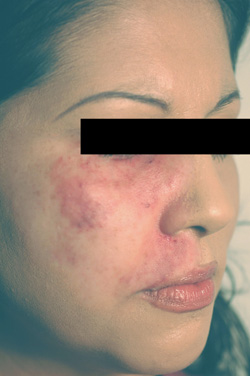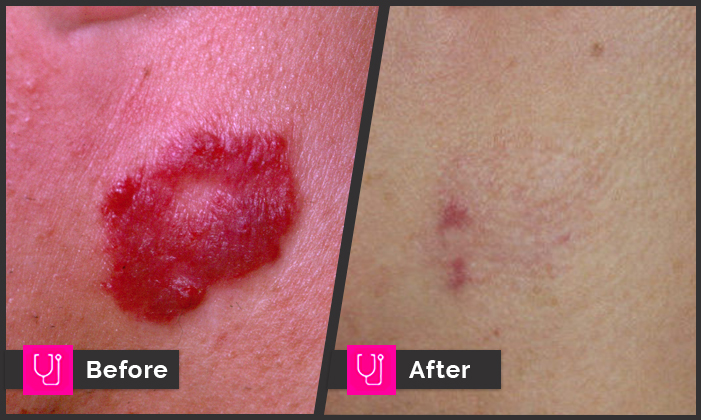

The heat within the vessel lumen causes blood vessel damage which is evidenced by intense purpura (“bruised” appearance of the skin).
PORT WINE STAINS TREATMENT SKIN
Yellow light produced by the pulsed dye laser penetrates up to 2 mm into the skin and is preferentially absorbed by hemoglobin within the dilated PWS blood vessels. The pulsed dye laser in conjunction with cryogen spray cooling (“dynamic cooling device” or “DCD”) is now the treatment of choice for PWS. The Treatment of Choice A patient with an extensive portwine stain before and after treatment with a pulsed dye laser. For all of the above reasons, most medical specialists agree that it is essential to begin treatment of PWS as early as possible and to maintain treatment in order to prevent the development of vascular nodules and hypertrophy in later years. The hypertrophy (increased tissue mass) of the underlying soft tissue that occurs in approximately two-thirds of lesions further disfigures the facial features of many patients. If left untreated, PWS often become incompatible with normal life due to the development of vascular nodules on the skin surface which can often bleed spontaneously with incidental trauma. Bleeding can be difficult to control, necessitate hospitalization and may also increase the likelihood of skin infection. Over time, blood vessels become more dilated and susceptible to spontaneous bleeding or hemorrhage following minor trauma. These changes in color and contour are attributed to progressive ectasia of the abnormal dermal vascular plexus. However, the lesions tend to darken progressively to purple and, by adult age, often become raised as a result of the development of vascular papules or nodules.

In infants and young children, PWS are flat red macules. PWS are well demarcated and flat and grow proportionately in surface area with the child. PWS remain throughout life there is no involution. PWS is a progressive vascular malformation of the skin. As a result, the blood vessels are unable to constrict normally and remain permanently dilated. The most likely hypothesis for the development of PWS is the deficiency or absence of surrounding neurons regulating blood flow through the ectatic post-capillary venules. It is believed that PWS develop within the first 2-8 weeks of gestation. The cause and origin of PWS remains incompletely understood. Detailed studies have documented lower self-esteem and problems with interpersonal relations in PWS patients. PWS should not be considered a cosmetic problem but a disease with potentially devastating psychological and physical complications. Since most of the malformations occur on the face, PWS is a clinically significant problem in the great majority of patients. Check out this Web-MD article or this slideshow of port wine stains at the Mayo clinic. There are no known risk factors or ways to prevent PWS. There appears to be no hereditary predilection for PWS within families. PWS occurs in an estimated 3 children per 1,000 live births, affecting males and females and all racial groups equally.

It involves post-capillary venules which produce a light pink to red to dark-red- violet discoloration of human skin.
PORT WINE STAINS TREATMENT DOWNLOAD
Vascular Birthmarks Legislative InitiativeĬlick the image below to download a free copy of the “ASLMS/VBF Laser Treatment Best Practices” booklet.Ĭlick the image below to download a free copy of the “ Port Wine Stain/Port Wine Birthmark (Capillary Malformation): Frequently Asked Questions” booklet.Ī Port Wine Stain (PWS) birthmark, also called nevus fla mmeus, is a congenital, cutaneous vascular malformation.American Academy of Dermatology Guidelines of Care.American Academy of Pediatrics Guidelines for Hemangiomas.


 0 kommentar(er)
0 kommentar(er)
